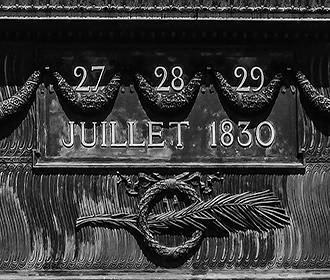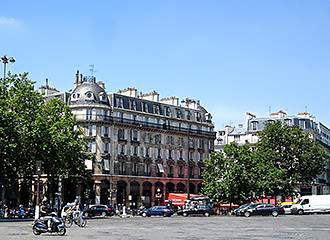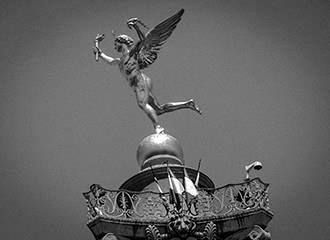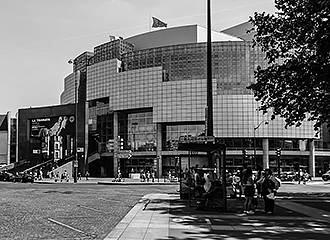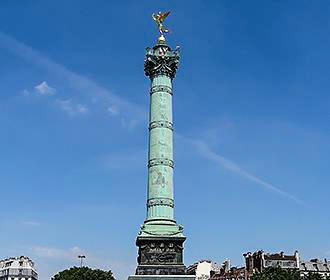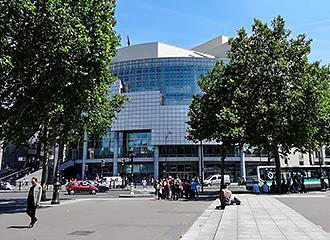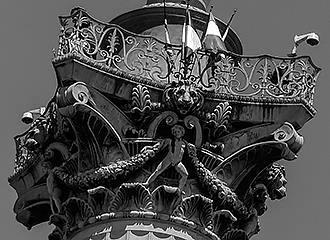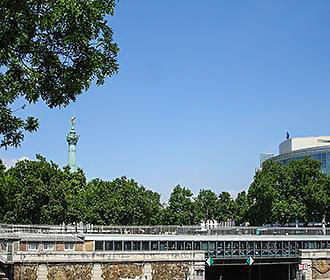Paris Place de la Bastille History and Bastille Prison
The Paris Place de la Bastille history and the Bastille fortress, that was turned into the notorious Bastille prison, starts way back in the 1300s hundreds during the One Hundred Years war between France and England, where unfortunately France was defeated at Poitiers in the Poitou-Charentes region, it was decided that a fortress was needed in order to protect the city of Paris.
Even though this defeat was in 1356, the construction of the fortress never began until 1370, which was at first under the reign of King Charles V and was designed to protect the medieval city against any attacks from the opposing armies.
The design was to be of a building that would have eight towers, which were to be well over 22 metres in height and these were built close together and surrounded the courtyards plus the armoury.
Also the design called for the outer walls to be over 4 metres thick and to have narrow slits built into these so that it gave light inside, and then you had a moat that went completely around the whole fortress.
This fortress was originally called the Chastel Sainte-Antoine, but construction of this fortress was not completed until around 1382 under the reign of King Charles VI, and it became known as The Bastide, which is the old French name for a fortress. Yet over time this became the name we know it as today, The Bastille, which is why the square where it was located is called the Place de la Bastille.
Anyway, getting back to the Paris Place de la Bastille history, obviously the Bastille was used as a fortress, but it was also a castle and home to the royal treasure, as it was decided that this was the most secure place in Paris. And the role of a stronghold for the treasure of the monarchy continued up until the 17th century.
The Paris Bastille Prison
It was during the reign of King Louis XIII under the orders of Cardinal Richelieu, that the fortress was to be converted into a prison for the upper class, which was during the first half of the 17th century and mainly because these were to be prisoners that were enemies to the king or had already committed high treason.
During this period in the history of Paris, it became one of the dark symbols, especially when a letter de cachet, which basically translates to a letter of royal seal was received from the king informing you that you would be detained in the Bastille prison. In fact, there are only a few of these letters in existence today and one of the original letter de cachet, which dates from 1765, is now housed within the Musee Carnavelet museum in Paris.
However, because those that were detained at this time were classed as upper class citizens, the living conditions at the Bastille prison where they were imprisoned was actually quite comfortable, as they were given a daily ration by the Paris government that provided them with luxury cuisine.
The upper class prisoners were also able to have visitors, their own furniture, clothes, books for study and even have their own servants and even though it started out as a prison for those opposed to the king, it ended up including those opposed to the Catholic religion and free thinkers.
Some of the wealthy aristocrats also had members of their own family committed and sent to prison at the Bastille whether it be because they were classed as insane, had done some kind of wrongful deed that the family deemed unfit, or just purely for their own protection.
Even Francois-Marie Arouet Voltaire was arrested and imprisoned at the Bastille prison. However, even though he was against religion and a free thinker, he was also a remarkable writer and eventually he had his place in history, as he had his remains brought back to the Pantheon in a fabulous ceremony, which is where he remains even today.
Unfortunately, with the letter de cachet issued by the king of France to numerous people, the Bastille prison became a place of hatred, fear and then had a terrible reputation, as it also started to imprison commoners.
Now, the governor was given an allowance that he could spend on an individual prisoner at the Bastille, and this varied greatly from a person that was a commoner, right through to academics or aristocracy, and yet this was still a better environment than some other prisons in France.
During the reign of King Louis XV, the Bastille prison started to accommodate more and more commoners in far less comfortable conditions than those of the intellectuals or aristocracy. Yet the subterranean cells called cachots, that were dirty, infested with rats, had the remains of people that had been tortured to death, etc were no longer used by the later half of the 18th century.
But one of the most documented prisoners over the years was known as the man in the iron mask that has conjured up much speculation and many legends over the years, even with films being produced about this prisoner and yet no one knows who this person was, as he was to be silent and masked at all times. Speculation has come up with numerous ideas as to his identity such as Oliver Cromwell, or even King Louis himself!
There were many prominent figures that were imprisoned in the Bastille prison throughout the 1780s, although the government were thinking about demolishing the prison due to the costs of running it and by the time the Storming of the Bastille occurred, there were very few people remaining imprisoned.
Storming of the Bastille prison
As many of you will know, the Storming of the Bastille prison was to mark the start of the French Revolution, but this all started with France being in financial crisis and the Constituent Assembly, which was put in place to create the French constitution were in constant discussions at the Palais Royal in Paris.
The king, who was residing at Chateau de Versailles, dismissed his finance minister, Jacques Necker, under the orders of the council and news of this reached Paris the following day on 12th July 1789.
People were rallied together bearing arms, which made many of the foreign troops flee from the city and crowds began to form, marching through the streets and to Place Vendome, where there was a German army. The crowds also went to Place Louis XV, which is now known as the Place de la Concorde and it was here that soldiers started to attack and kill the demonstrators.
These demonstrators were initially gathered at the Hotel de Ville as they wanted arms, but eventually they attacked the Hotel des Invalides for arms, gunpowder and guns, then continued on to the Bastille prison for the same reason.
However, two people were allowed into the Bastille prison for negotiations, but by around 3pm on the 14 July 1789, the crowd that was gathered outside the prison had become more and more agitated and eventually they stormed the outer courtyard of the Bastille and cut the drawbridge to the inner courtyard.
The governor of the Bastille prison, eventually produced a note for a ceasefire, but this was refused and eventually, he opened the gates to the inner courtyard and the Bastille fortress and prison was liberated.
Yet, ironically, there were only seven prisoners still being held at the Batille prison, but the governor Launay was stabbed to death and then his head was put on a spike and carried through the streets, so hence the French Revolution had begun.
Demolition of the Bastille prison and fortress
After these events in 1789 the fate of the Bastille prison and fortress was uncertain, but very shortly after, it started to become more like a memorial place, as many notable people would visit this Paris monument.
However, a building contractor and entrepreneur by the name of Pierre-Francois Palloy embarked on being able to demolish this building and he managed to secure a licence for the demolition only a matter of days after the Storming of the Bastille.
He was in complete control of the project along with his team of workers, that was nearing on 1000 men, but being an entrepreneur, he had visions of this being a paid attraction, which is when he started to sell bits of stone, rubble and other items as souvenirs, with each piece being accompanied by a certificate of authenticity.
Models were also made at this time, and some of these are now on display within the Musee Carnavalet in Paris.
The demolition of the Bastille prison was rapid and by November of that same year, there was hardly any parts remaining, however, a fair bit of the stone was used in the construction of the Pont de la Concorde bridge across the River Seine.
It was then, one year later, that Palloy held a party amongst the ruins to celebrate and a banner read "here we dance", which was the start of the very first 14th July celebrations, which has become the most recognised of all French National holidays.
Some stones from one of the towers were discovered in 1899 when the area was being excavated ready for the Metro station and these were moved to a park in 1900, called the Square Henri-Galli, which is where you can still see them on display, with a plaque.
Also, in the Bastille Metro station itself on the line 5 platform going in the direction of Bobigny, there is an exhibit of some of the remains from the eastern moat of the old Bastille fortress and prison as well, but these pieces are all that remain of this imposing structure that caused fear and hatred for many.
Additionally, on the ground at the Paris Place de la Bastille you can see coloured stones that are there to show the exact location and dimensions of the Bastille prison as it was all those years ago.
